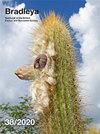玻利维亚南部扁花的授粉生态
IF 1.2
4区 生物学
Q3 PLANT SCIENCES
引用次数: 1
摘要
概述:Phemeranthus punae(R.E.Fr.)Eggli&Nyffeler(Montiaceae)是一种多年生土生草本植物,产于玻利维亚西南部和阿根廷西北部安第斯山脉的普纳前植被中。开花植物已经观察了好几个季节。花几乎只被至少三种蚂蚁造访(蚁科:可能是Forelius pruinosus Roger、Linepithema sp.和Camponotus bruchi Forel)。蚂蚁在植物上自由快速地移动,并在不到五秒内切换到相邻的植物。花粉粒附着在蚂蚁的腿和身体上,蚂蚁会造访花朵以获取花蜜。P.punae的低身材、水平展开到上升的花序和小花符合Hickman(1974)提出的蚂蚁授粉综合征特征。结论是,观察到的蚂蚁是研究区域内该物种的传粉昆虫。本文章由计算机程序翻译,如有差异,请以英文原文为准。
The pollination ecology of Phemeranthus punae (Montiaceae) in southern Bolivia
Summary: Phemeranthus punae (R.E.Fr.) Eggli & Nyffeler (Montiaceae) is a perennial geophytic herb from the pre-Puna vegetation in the Andes of south-west Bolivia and north-west Argentina. Flowering plants have been observed for several seasons. Flowers are almost exclusively visited by at least three species of ants (Formicidae: likely Forelius pruinosus Roger, Linepithema sp. and Camponotus bruchi Forel). The ants move freely and rapidly on the plants and switch to neighbouring plants within less than five seconds. Pollen grains adhere to legs and bodies of the ants, which visit the flowers to feed on the nectar. The low stature of P. punae, its horizontally spreading to ascending inflorescences and the small flowers conform to the ant pollination syndrome characteristics formulated by Hickman (1974). It is concluded that the observed ants are the pollinators of the species in the study area.
求助全文
通过发布文献求助,成功后即可免费获取论文全文。
去求助
来源期刊

Bradleya
PLANT SCIENCES-
CiteScore
2.80
自引率
25.00%
发文量
43
审稿时长
>12 weeks
期刊介绍:
Bradleya is the BCSS contribution to the scientific world and is accepted as such because of its academic standards. It can only flourish with the support of BCSS members, many of whom subscribe to it each year. The aim is to include articles which our members will find interesting and educational, whilst retaining rigorous standards of publication. Scientifically important articles don''t have to be dull to read. So, because Bradleya depends the subscriber, the editor endeavours to make its contents accessible, easily understood and enjoyable for all.
 求助内容:
求助内容: 应助结果提醒方式:
应助结果提醒方式:


